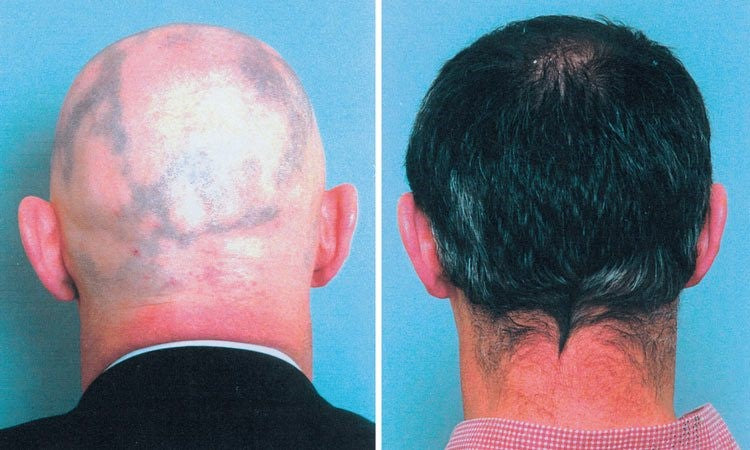https://www.hairverve.com/wild-growth-hair-oil-reviews/
The 9 Ingredients Of Wild Growth Hair Oil – Can It Really Re-Grow Hair After 60 DAYS?

Whether you’re only now beginning your journey of hair loss treatment, or you’ve been sampling various treatment products and supplements for years, you may have come across Wild Growth Hair Oil (WGHO) as a way to re-grow your hair.
Of course, as with anyone looking for genuine results, you may be asking yourself, “does this stuff really work?”
As with any other product, the answer is, “it depends.”
However, to provide you with a better answer, I’ve taken a deeper look at the product and its ingredients. So that you can learn more about the product prior to usage, in the sections below, you’ll discover:
- The individual ingredientsfound within WGHO and the hair growth benefits they may provide;
- The result claimsoffered by WGHO;
- Who is an ideal candidatefor this treatment;
- Researchfindings surrounding the oil’s various ingredients;
- Possible side effectsassociated with application of the oil;
- An explanation for how WGHO is typically used; and
- An accurate price breakdownof the oil.
Finally, after reading the article why not try my new 6 question quiz found at the bottom of this page. Based on the answers your give it will calculate a score for you – the higher the score, the more likely that this oil and other natural oils will work successfully to re-grow your hair.
What Ingredients are Found in WGHO?
As is to be expected, the formulation of the oil will tell us a lot about what it can do for individuals with hair loss.
Here’s a breakdown of the ingredients and some hair growth benefits each ingredient may provide:
Olive Oil

This moisturizing, inflammation-fighting ingredient can reduce scalp inflammation, induce anagen hair growth, and has even been shown to be more effective than minoxidil when treating hair loss.
Jojoba Oil
Nearly identical to the structure of sebum, the oil produced by sebaceous glands, jojoba oil has been shown to be effective in generating hair growth (and even new hair follicles!).
Coconut Oil
Coconut oil’s unique structure allows it to penetrate the hair shaft, better than even mineral oil and sunflower oil.
This ingredients provides your hair with necessary moisture and can also prevent the loss of protein in hair strands.
Vitamin D
Deficiencies in Vitamin D have been shown to interrupt the chemical processes involved in hair growth, and can even lead to the breaking down and loss of already-present hair.
Choline
This vitamin, vital to the health of the liver, brain, nerves, and muscles, is also known to have moisturizing properties which may lend itself to hair growth benefits.
Inositol
While research studies have found that inositol has no effect as a treatment for alopecia, the application of inositol did appear to have beneficial and rapid effects on various skin conditions.
Iron
An element found within the human body, iron plays a critical role in the circulatory system. As part of the bloodstream, iron deficiencies can lead to health problems seen throughout the body, including hair thinning and balding.
Magnesium
A lot of effective hair loss treatment methods are concerned with the balancing of chemical imbalances within the bloodstream and scalp.
Magnesium is no different, balancing the levels of calcification found within the hair follicles and levels of calcium within the bloodstream.
Phosphorous
Practitioners of homeopathy have looked for years at phosphorous as a successful treatment option for individuals suffering from alopecia areata, a patchy form of hair loss.
Calcium

While magnesium seeks to balance the overabundance of calcium within the body, that doesn’t mean that calcium supplementation is harmful or necessary.
In fact, calcium is a vital nutrient which can only be found in food sources, and a deficiency of calcium can cause weakening of the bones and increased risk of kidney stones.
Natural Color and Fragrance
This catch-all phrase is found as the last item on the lists of a variety of cosmetics and hair care products.
And, while you may be kept in the dark as to the exact colorants and fragrances used, only those listed by the FDA as “natural” may be listed as such.
What Does WGHO Claim?

So, what does Wild Growth claim about their hair oil, and should these claims be taken seriously?
First and foremost, they say they’ve had hair growth results in 95% of Wild Growth Hair Oil users.
This statistic, however, has been collected from the testimonials and survey results provided by users, and has not been verified in a research study or review.
Additionally, WGHO boasts an array of hair benefits, though none of these are backed by research.
Such benefits include the product’s promotion of thick, long hair growth, its detangling and softening abilities, and its effective use as hair strengthener and protector.
Now, does the lack of studies mean that the product is ineffective?
Absolutely not!
However, hair growth results are certainly not guaranteed, and the decision whether to utilize the product for hair loss treatment is up to your discretion.
Who Will Benefit from WGHO Use?
They claim their products work on a variety of hair types, including black/African, Asian, European, Indian, Middle Eastern, Native American, and Central/South American.
For individuals with particularly oily scalps or fine hair, WGHO may still be used, though it’s important to keep in mind that a little oil goes a long way.
Does Scientific Research Back Wild Growth’s Success Claims?
While no research has been done specifically on WGHO and its effectiveness as a treatment for alopecia, studies have been done on various ingredients found within the product.
This is certainly not an exhaustive list, though I have included research which I believe will be most helpful for you in your decision making.
Olive Oil
I’ve recently explored the use of olive oil as a hair loss treatment option.
And, while you shouldn’t expect olive oil to reverse the effects of aggressive hair loss, there are a few components found within it (namely, oleuropein and oleocanthal) which seem to contribute to its use in the prevention of further hair loss.
In my previous research, I discovered a study which tracked the hair growth results of mice within a 28-day period.
The results of the study showed that, not only did the daily application of oleuropein prove to be more effective than the application of a control vehicle, but it also beat out minoxidil in hair growth results.
Further, the phenolic compound known as oleocanthal was shown to reduce inflammation which, when chronic, can damage hair follicles and cause premature hair loss.
Without the right nutrition you'll be fighting a losing battle. Get my 1-week Meal PlanPDF sent to your email inbox, so you know what meals to eat for optimal hair protection & regrowth.
Just enter your email address below and click "Send Me The Meal Plan" and I'll send you the PDF right away so you can continue reading this article.
Download My Hair Growth Nutrition1-Week Meal Plan
Top of Form
Send The Meal Plan
Bottom of Form
SPAM PROTECTED

Jojoba Oil
Another oil found in WGHO’s formulation is jojoba oil, a waxy substance which has been used commonly for the treatment of hair-, skin-, and nail-related issues.
One study, performed by Hay et al, utilized a combination of essential oils and carrier oils (in this case, jojoba and grapeseed) to determine its effectiveness at treating alopecia areata.

Now, while researchers were focusing on aromatherapy’s impact on hair growth, that’s not to say that the two carrier oils, jojoba and grapeseed, didn’t play their roles as well.

A comparison between the active group (received essential oils with either jojoba oil or grapeseed oil) and control group showing the reduction in area affected by hair loss.
Coconut Oil

The penetrative abilities of coconut oil contribute to its use as a successful moisturizer, as well as its effectiveness at preventing the loss of protein in the hair.
In figure 1 on the right, the protein loss seen in undamaged hair following the application of coconut oil and sunflower oil is illustrated.
Results show that, applied both as a pre-wash and post-wash, coconut oil leads to less protein loss from wet hair brushing than does sunflower oil.
Vitamin D
While human studies are limited, a review of scientific literature regarding the role which Vitamin D plays in hair loss was performed by Amor, Rashid, and Mirmirani in 2010.
Scientists found that, while the role of Vitamin D in hair loss and regrowth was still unclear, the Vitamin D receptor did play a vital role in hair cycling, including the initiation of the anagen phase of hair growth.
As a result of this review, the three researchers suggested that treatments which regulate the Vitamin D receptor may be successful forms of hair loss treatment and should be further studied.
According to a different study, it appears to be that low Vitamin D levels due to the effects of hereditary Vitamin D receptor deficiency may play a role in the development of telogen effluvium.
This is a very common cause of hair loss, but one which may be preventable with Vitamin D supplementation.
Telogen effluvium can be caused by a triggering event, or it can be chronic. Either way, the condition can cause brittle, thinning hair and may also lead to the dislodging of hair from the follicle.
Choline
One example of choline’s use in the treatment of hair loss is seen in a 2007 study by Wickett et al.
Forty-eight women, all of which had fine hair, participated in this study. They were treated for nine months with either a 10mg/day dose of choline-stabilized orthosilicic acid or a placebo.
At the end of the study, researchers studied the effects of choline-stabilized orthosilicic acid on elasticity, break load, and hair thickness.
While elasticity decreased in both groups, the group which received the supplement only say a 4.52% reduction compared to the 11.9% reduction in elasticity seen in the placebo group.
Additionally, the placebo group saw a 10.8% decrease in break load, while the group which received the supplement only saw a 2.20% decrease in break load.
Iron
A 2013 Korean study linked pattern hair loss to lower levels of serum ferritin, the protein within the body which is necessary to store iron.
This study strongly supports the link between iron deficiency and the progression of female-pattern hair loss, and further studies may be beneficial in discovering the why behind these results.
Magnesium
As I established in a previous article, an excess of calcium in the bloodstream and hair follicles can cause chronic inflammation.
And, as you know, inflammation has a direct impact on the hair follicle, leading to miniaturization of the hair follicle and hair loss.
Magnesium, however, has been shown to reduce the levels of calcium found in blood vessels. This means that inflammation caused by calcium can be decreased—and even reversed—when magnesium is used.
So, Can WGHO Treat Hair Loss?
While a number of the ingredients found within the oil have been shown to contribute to hair growth or the slowing of hair loss, this doesn’t mean that the combination found within the product offers any additional benefits apart from the ones previously mentioned.
Simply put, while WGHO may provide you with a convenient source of nutrients and natural ingredients, it doesn’t have any superior benefits over a homemade combination of your own.
Side Effects Associated With WGHO
As with the supplementation of anything, adverse effects and allergic reactions are always a possibility.
Even with the use of natural ingredients, such as those seen in WGHO, you may still experience sensitivities or reactions to one or more of the product’s constituents.
To determine whether this product will cause a reaction, apply to the inside of your wrist prior to scalp application. This will ensure, if a reaction does occur, that the reaction is contained.
As with any of the supplements featured on Hair Loss Revolution, individuals with chronic health conditions, or women who are pregnant or nursing, should consult with a medical professional before beginning use.
How Is The Oil Best Used?
It can be used on either damp or dry hair, though the results you’re looking for, as well as your hair type, will largely determine how you apply the oil and how much to use.

Apply to Damp Hair
For Coarse Hair
Split your hair into four parts, and apply 15-20 drops of the oil to each section. After application to each of the four sections, apply to the scalp thoroughly while avoiding saturation.
Let the oil soak into your scalp for 3-5 minutes and, using the tool of your choice, detangle, brush or comb the oil through your hair.
You may now style as usual.
For Fine Hair
For the entirety of your hair and scalp, apply 5-10 drops to your palms and apply.
Let the oil soak for 3-5 minutes, and then comb or brush through your hair to evenly distribute the oil.
You may continue brushing your hair every 3-5 minutes until your hair has completely air dried in order to lessen the amount of oil present on your scalp, or leave as is following application.
If the application has left your scalp and hair feeling too oily, apply less until you’ve found the right amount for your scalp.
Apply to Dry Hair
For Coarse Hair
Between washings, you’ll want to apply the oil sparingly as scalp flakiness or dryness occurs. Additionally, you can use the oil as a frizz fighter.
For Fine Hair
Using wet hands, apply 3-10 drops of the oil to the thickest parts of your hair, and slowly make your way out to areas of thinner growth.
To rid scalp of oil residue, allow the oil to soak for 3-5 minutes, and then brush every 3-5 minutes thereafter in order to ‘set’ the hair and allow maximum oil absorption and dispersal.
Availability and Cost of WGHO
As an over-the-counter hair care product, WGHO is available online (both in the U.S. and in various non-U.S. countries, such as Australia, the UK, India, and Nigeria) as well as in various independent and chain cosmetics stores throughout the United States.
A single 4 oz. bottle of the oil is available, from Amazon, for $9.99, though to save money, you may want to consider the 2-pack option (2 4-oz bottles) for a total of $14.39.
Conclusion
At the beginning of this article, we sought to answer the question, “is Wild Growth Hair Oil an effective treatment option for individuals with alopecia?”
As outlined above, while the various ingredients found within the product, such as olive oil and Vitamin D, may provide benefits for users, that doesn’t mean that the product will work for you, or that you cannot get these benefits on your own.
If you’re still unsure whether you’d like to give it a try, or you just want to learn more about the type of hair loss you suffer from, take the quiz below to discover all-natural treatment methods which may be better suited for you.













